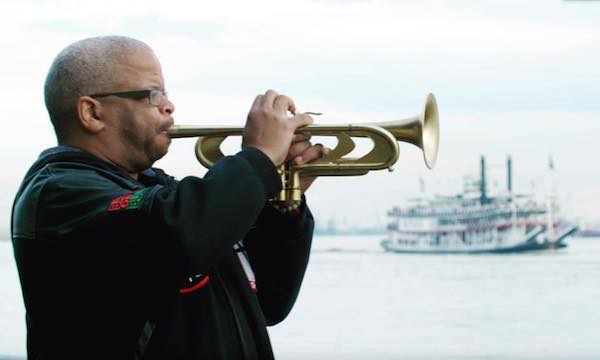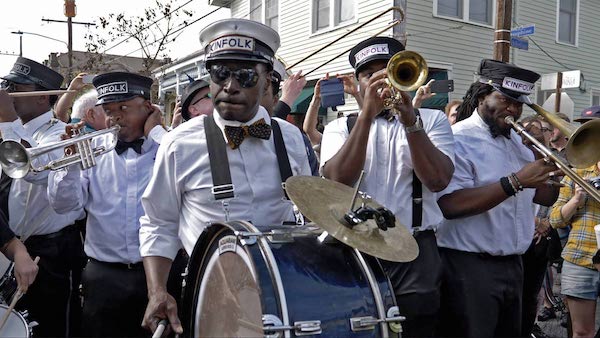Music Documentary Review: “Up From the Streets” — New Orleans’ History of Oppression and Creativity
By Clea Simon
Up From the Streets is no New Orleans Jazz and Heritage Festival — but it tries.
Up From the Streets, directed by by Michael Murphy.

Trumpeter Terence Blanchard in the documentary Up From the Streets, streaming through May 21.
In a better world, I’d be just back from New Orleans. Every spring since 1989, I’ve attended at least one weekend of the New Orleans Jazz and Heritage Festival (Jon has joined me since 1993). This annual festival — always the last weekend in April and the first in May — has, since 1970, celebrated not just the namesake music but also, truly, the heritage. With its mind-boggling array of food booths, crafts, and demonstrations packed onto the Fair Grounds Race Course, the event presents this multicultural city in a nutshell. Despite the usual gripes — the crowds have grown too big, too many headliners have nothing to do with the Crescent City (this year would have brought The Who), the ticket prices have gone up astronomically — it’s still reliably wonderful, and I was always happy to pack in with the something like 200,000 annual visitors. Until, of course, we couldn’t.
Because even before we grabbed another bowl of Prejean’s awe-inspiring pheasant, duck, and andouille gumbo, the Fest, as it’s known, always offered, along with those international superstars, an across-the-spectrum selection of New Orleans music. There was trad jazz in the Economy Hall tent, zydeco on the Fais Do Do stage, brass bands, jazz, and blues. Over the past few years, we’d grown used to starting our day with whatever Mardi Gras Indian gang was opening at the Jazz and Heritage stage and taking it from there.
That absence makes the release of Up From the Streets bittersweet. This 104-minute film, directed by Michael Murphy with four-time Grammy winner Terence Blanchard as executive producer, music director, and host, should have been on the film festival circuit this spring. Already the recipient of the Documentary Feature Award of Excellence at the Indie Fest Film Festival and the Juried Gold Award Winner for Best Feature Documentary at Houston WorldFest Film Festival, it is currently available as part of a virtual festival through May 21 to stream, for a fee of $12, part of which goes to support the New Orleans Jazz & Heritage Foundation’s Jazz & Heritage Music Relief Fund and part of which goes to the cinema that would have screened the film. (Viewers, who have 72 hours to watch the film once they have purchased it, have such options as Provincetown’s Waters Edge Cinema or the Amherst Cinema.)
The documentary is no Fest, but it tries. A bit of a laundry list, much of the film plays like a survey course, ticking off, via photos, film clips, recordings, and testimonials, Buddy Bolden, Louis Armstrong, Mahalia Jackson, Fats Domino, Professor Longhair, Dr. John, and on up through bounce rapper Big Freedia. There’s solid musicology here. Murphy pays tribute to the music’s European sources — New Orleans had regular opera performances as early as 1796 — as well as the diversity of the African cultures that contributed various harmonic or rhythmic styles. (Ned Sublette’s The World That Made New Orleans offers the ultimate dissection of the different African and European contributions.)
These musical influences are set into historical context. Up From the Streets doesn’t shy away from the fact that the roots of so much of this art lies in slavery — particularly slavery as it was experienced in New Orleans. Under French control from 1682 to 1762 and again 1801 to 1803, the city allowed enslaved people one day a week to gather, play drums, and dance as they or their parents once had in Africa. This not only kept the music alive, it allowed it to evolve and syncretize with other styles, including contributions from the Caribbean, following the exodus after the Haitian revolution. The result was something truly new — jazz.
This history of oppression and creativity continued after emancipation through the travails of African American musicians trying to tour and earn a living under Jim Crow. Meanwhile, jazz and blues expanded, melding with gospel, inspiring soul and R&B and, of course, rock and roll. As times changed, musicians such as Mahalia Jackson on down lent their talents to the Civil Rights movement. Murphy traces this evolution by way of the city’s musical trademark, its distinctive syncopation – a kind of backwards clavé — as it moved into its present-day incarnations, from Ivan Neville carrying on his family’s traditions with Dumpstaphunk to the bouncy pop stylings of Tank and the Bangas.
Although the film includes white faces — Fest producer Quint Davis; Ben Jaffe, a second-generation music preservationist and currently creative director/tubist/bassist with the Preservation Hall Jazz Band; and superstar pianist/actor Harry Connick Jr., among others – it rightly focuses on the African American musicians and their legacy. It’s a complicated story, one that many of these musicians had to play both sides of to survive, and Murphy chooses his examples with care. Louis Armstrong, for example, took critical flak for acquiescing to some aspects of apparent minstrelsy during his long career. But Murphy focuses on Armstrong’s groundbreaking musicianship as well as the points he could make, such as replacing “sleepy time” with “slavery” during a session recording his signature song, “When It’s Sleepy Time Down South.”
It’s a history — and a battle — that continues to this day. A native of the city, Blanchard recalls seeing the statue of Confederate General P.G.T. Beauregard come down in 2017. With his emotion clear in his voice, Blanchard explains that this statue, which he passed every day on his way to high school, was simply a part of the landscape and yet, when it was winched up, he felt a huge weight taken off his shoulders. A weight he hadn’t known was there.

A scene from Up From the Streets.
Through it all, the music has continued. Except, that is, for the silence. That’s how August 2005’s Hurricane Katrina — aka the federal flood, as many in the city recall it — is remembered by Connick. The by-now familiar, horrible footage of water as high as street signs, of people on their rooftops, is interspersed with Connick and others talking about how disturbing, how unnatural the lack of music and crowd noise was. Jaffe, who was living just off Frenchman Street, recalls how that nonstop street of clubs was devoid of human sounds. From there, a choked-up Davis recalls Mitch Landrieu, then the lieutenant governor of Louisiana, talking to him about how Fest had to come back. The Fairgrounds was flooded, there was no electricity, and yet, eight months later, they did it.
Murphy includes footage of that wonderful, joyful revival. It features Bruce Springsteen’s emotional closing set on the big stage: hundreds of thousands waving and singing (and crying) along to “My City of Ruins.” But he then wisely turns to Irma Thomas joining Paul Simon on “Bridge Over Troubled Water” — Allen Toussaint on piano, naturally –and her powerful voice, finding the gospel in the pop song to help the healing along.
This year, the novel coronavirus did what a Katrina couldn’t. The festival was first postponed, then canceled. Watching this film and seeing Toussaint, Dr. John, Fats… so many of the musicians featured here are gone. (Earlier this month, Irma allowed New Orleans’ Jazz and Heritage station WWOZ to rebroadcast two live sets as a recreation of her annual Mother’s Day performance, and her prerecorded message, which sounded like it had been done on an iPhone, was so wonderful to hear.) The virus has hit this city hard, and its population of music makers — largely African American, many afflicted by the preexisting health conditions endemic in a historically oppressed population — has taken huge losses. Can it come back again?
A few years ago — 15? more? – I recall wandering into a small record store alongside St. Louis Cathedral, in Pirate’s Alley. There, alongside a smartly curated collection of traditional jazz rarities and local pressings, Jon and I found a good selection of bounce — the New Orleans rap that carried on the latest manifestation of the African-Caribbean beat. CDs and singles by 5th Ward Weebie, Master P, Mystikal, and others filled out a full corner of what was otherwise a very old-school shop. The proprietor, a white-haired gentleman with a British accent, answered our questions about the then-burgeoning scene, telling us about gigs he’d been to and where to find the latest. How did he know? The question — even directed to an older, white, non-New Orleanian native — seemed almost rude to ask, and yet we did. The answer, as I recall, was simple: “I know many of these young artists’ fathers,” he told us. “They’re jazz musicians.” He gestured eloquently to the remainder of his stock. Community, indeed.
Clea Simon’s most recent novel is An Incantation of Cats: A Witch Cats of Cambridge Mystery. She can be reached at www.CleaSimon.com.
Tagged: Clea Simon, Michael Murphy, New Orleans, Terence Blanchard

I live in Nola now, been here for about six months. I love it.
And I take CV seriously– what fool wouldn’t?– but it’s itching at me how I have to miss out on exploring the city and Jazz Fest, which I had tickets for and was looking forward to.
I’m definitely going to watch this movie, that’s a given, so I’m grateful that you have written it up for me.
Man, I cannot WAIT for when we are safe enough to let things happen here again. It’ll be something, I’m sure of that….
Can’t wait till we can return. In the meantime, did you catch WWOZ’s “Festing in Place” broadcasts? I swear that station is keeping me sane, and friends in NOLA have told me about hearing it from backyards and porches through both those weekend. Stay well!